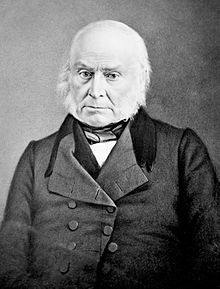|
United States of America
John Quincy Adams – 6th President
1970 Proof Silver Medal 39mm (33.18 grams) 0.925 Silver
JOHN QUINCY ADAMS 1825 SIXTH PRESIDENT OF THE UNITED STATES 1829, John facing 1/3 left.
JOHN QUINCY ADAMS BORN JULY 11, 1767 MARRIED LOUISA JOHNSON, 1797. ONLY PRESIDENT WHOSE FATHER HAD ALSO BEEN PRESIDENT; A GREAT INDEPENDENT THINKER, DEBATER AND FIGHTER FOR HUMAN RIGHTS. DIED FEB. 23, 1848., Eagle with arrows in claws right atop American shield with stripes and stars.
You are bidding on the exact item pictured, provided with a Certificate of Authenticity and Lifetime Guarantee of Authenticity.

John Quincy Adams (July 11, 1767 – February 23, 1848) was an American statesman, diplomat, lawyer, and diarist who served as the sixth president of the United States, from 1825 to 1829. He previously served as the eighth United States Secretary of State from 1817 to 1825. During his long diplomatic and political career, Adams also served as an ambassador, and as a member of the United States Senate and House of Representatives representing Massachusetts. He was the eldest son of John Adams, who served as the second president of the United States from 1797 to 1801, and First Lady Abigail Adams. Initially a Federalist like his father, he won election to the presidency as a member of the Democratic-Republican Party, and in the mid-1830s became affiliated with the Whig Party.
Born in Braintree, Massachusetts (now part of the town of Quincy), Adams spent much of his youth in Europe, where his father served as a diplomat. After returning to the United States, Adams established a successful legal practice in Boston. In 1794, President George Washington appointed Adams as the U.S. ambassador to the Netherlands, and Adams would serve in high-ranking diplomatic posts until 1801, when Thomas Jefferson took office as president. Federalist leaders in Massachusetts arranged for Adams’s election to the United States Senate in 1802, but Adams broke with the Federalist Party over foreign policy and was denied re-election. In 1809, President James Madison, a member of the Democratic-Republican Party, appointed Adams as the U.S. ambassador to Russia. Adams held diplomatic posts for the duration of Madison’s presidency, and he served as part of the American delegation that negotiated an end to the War of 1812. In 1817, President James Monroe selected Adams as his Secretary of State. In that role, Adams negotiated the Adams–Onís Treaty, which provided for the American acquisition of Florida. He also helped formulate the Monroe Doctrine, which became a key tenet of U.S. foreign policy. In 1818, Adams was elected a member of the American Philosophical Society in Philadelphia.
Adams, Andrew Jackson, William H. Crawford, and Henry Clay — all members of the Democratic-Republican Party — competed in the 1824 presidential election. Because no candidate won a majority of electoral votes, the House of Representatives held a contingent election, which Adams won with the support of Speaker of the House Clay, whom Adams would go on to controversially appoint as his Secretary of State. As president, Adams called for an ambitious agenda that included federally funded infrastructure projects, the establishment of a national university, and engagement with the countries of Latin America, but Congress refused to pass many of his initiatives. During Adams’s presidency, the Democratic-Republican Party split into two major camps: the National Republican Party, which supported President Adams, and Andrew Jackson’s Democratic Party. The Democrats proved to be more effective political organizers than Adams and his National Republican supporters, and Jackson soundly defeated Adams in the 1828 presidential election, making Adams the second president to fail to win re-election (his father being the first).
Rather than retiring from public service, Adams won election to the House of Representatives, where he would serve from 1831 until his death in 1848. He remains the only former president to be elected to the chamber. After narrowly losing his bids for Governor of Massachusetts and Senate re-election, Adams joined the Anti-Masonic Party in the early 1830s before joining the Whig Party, which united those opposed to President Jackson. During his time in Congress, Adams became increasingly critical of slavery and of the Southern leaders who he believed controlled the Democratic Party. He was particularly opposed to the annexation of Texas and the Mexican–American War, which he saw as a war to extend slavery and its political grip on Congress. He also led the repeal of the “gag rule”, which had prevented the House of Representatives from debating petitions to abolish slavery. Historians concur that Adams was one of the greatest diplomats and secretaries of state in American history; they typically rank him as an average president, as he had an ambitious agenda but could not get it passed by Congress.
|











